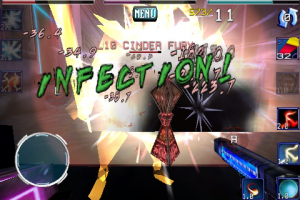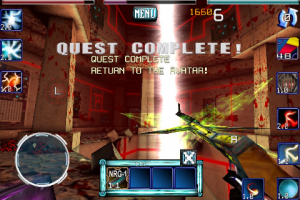 On the technical side, was there any one challenge you would point to as being toughest to solve, or did you want to implement any features you ultimately had to leave behind? Did you have to make any major adjustments to account for changing technology during Mission Europa’s development cycle – for example, did the advent of Retina Display take you by surprise at all?
On the technical side, was there any one challenge you would point to as being toughest to solve, or did you want to implement any features you ultimately had to leave behind? Did you have to make any major adjustments to account for changing technology during Mission Europa’s development cycle – for example, did the advent of Retina Display take you by surprise at all?
Collision models are always a joy. However, I think the artificial intelligence was the most difficult. The bad guys had to be able to figure rooms out because they are randomly generated. Along with that I wanted tons of them, so they did not get a whole lot of thinking time. I really did not leave out anything that I wanted, as people can see — don’t be surprised if you trip on a kitchen sink in there. As the testers were along for the ride since the first level, they also got almost all their wishes for the game. It was a truly different way to make a game.
As far as new tech, the funny thing about Retina is it scared the pants off of me when it popped out. I was thinking it might be a drastic change, adding months to development. In reality it took me ten minutes to get it up and running! That goes to show worrying gets you nowhere — just dive in.
 I was very surprised to find that Mission Europa’s voice acting crew consisted of a mere two individuals! Did you use voice distortion or other tricks to make each of the characters feel unique during cutscenes, and were you able to draw on samples for short in-game voice clips, or was that all you? Any special sound equipment or software involved during the recording process?
I was very surprised to find that Mission Europa’s voice acting crew consisted of a mere two individuals! Did you use voice distortion or other tricks to make each of the characters feel unique during cutscenes, and were you able to draw on samples for short in-game voice clips, or was that all you? Any special sound equipment or software involved during the recording process?
I love me some Sound Studio for Mac. My wife did Dr. Sierra and a highly modified yours truly the rest. Again, low budget is low budget. I think it does a pretty good job and without the voice overs you just cannot get the feeling of how the story is supposed to be delivered. When you take out the voice in a story you take out half of the meaning.
Mission Europa’s story might strike the player as pretty predictable at first, but once they spend a few hours on this frozen moon they’ll realize there’s a bit more under its surface than one might initially expect. Would you point to any particular piece of media as inspiring or influencing your approach to videogame storytelling? And what drew you to the idea of setting the game on Europa?
Event Horizon is one of the best movies ever made. I loved the blending of spiritual horror and space. I am a space junkie also. As the farthest outpost of man, Europa makes a great place if you use water for fuel and life. When beneath the ice you would be shielded from Jupiter’s radiation. You could melt tunnels out of the environment to create new structures. So many fun things you could play with about the planet. Let’s hope it sells enough for a sequel. 😉
 Now that Mission Europa is about to see release, do you have any specific plans for updates to the game, or have you started thinking about future projects already?
Now that Mission Europa is about to see release, do you have any specific plans for updates to the game, or have you started thinking about future projects already?
After launch I will be working closely with players on fixing things and modifying multiplayer. I plan on mailing items to first adopters as a reward, and other fun things. The sales of this game will decide if my wonderful wife will let me dedicate the time I did on M.E. to future projects. Currently I am already refactoring the SouL_EnginE into its next evolution and working with OpenGL ES 2.0.
If anyone ever has more questions, just pop by my blog. I am always looking for company at RyanMitchellGames.WordPress.com and twitter.com/BansheeSoft.
Thank you for your time and reading my ramblings!
-Ryan Mitchell,
BansheeSoft
iFanzine’s thanks goes to Ryan Mitchell and Doomfan for the screenshots used in this interview feature. Stay tuned for a truly monumental review once the wait for Mission Europa has finally ended!


